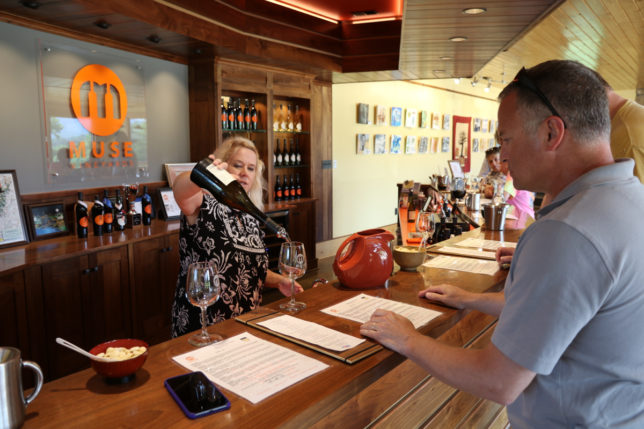Levity is the First U.S. Cider To Be Fermented in Georgian Clay Pots
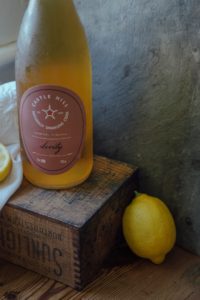 Castle Hill Cider has earned a silver medal for Levity, one of its flagship offerings. The international competition, Drink Outside the Grape, recognizes high-quality, locally grown fruit wines from as far as India and Israel.
Castle Hill Cider has earned a silver medal for Levity, one of its flagship offerings. The international competition, Drink Outside the Grape, recognizes high-quality, locally grown fruit wines from as far as India and Israel.
https://www.salernoformazione.com/idhdrmqn1f A unique method is used to make Levity. Castle Hill is the first producer in the United States to import and utilize qvevri, a terracotta vessel submerged underground to maintain cold temperatures. To create Levity’s unique effervescence and flavor profile, pressed juice ferments in the clay pots for three months, then is bottled for continued fermentation to create natural sparkle.
Qvevri are the oldest known fermentation vessels dating back 8,000 years to the country of Georgia. Traditionally, lids are sealed with clay and fern. At Castle Hill, lids are sealed with a closed-cell foam to avoid contamination.
“This is a small batch cider because of the intricate process of using the terracotta pots, ” Cidermaker Stuart Madany says. “Because qvevri do not have a drain, water is pumped out for cleaning. Smaller vessels are cleaned with a brush while larger vessels require us to climb inside. We clean the vessels without chemicals and they are relined with beeswax as needed to seal natural pores in the clay.”
https://hazenfoundation.org/7itb6gzg Levity is a blend of ten Virginia grown apples including Harrison Albemarle Pippin, and Winesap. Produced since 2010, the 2017 vintage brings aromas of caramel, lemon zest, black cherry, almond and guava. In the mouth, it is very full bodied with both astringent and bitter tannins, flavors of honey and tangerine and a very fresh preserved lemon finish and has an ABV of 7.9%
https://www.scarpellino.com/tsqbp47jl About Castle Hill Cider
Castle Hill Cidery, which opened its doors in 2011, resides on 600 beautiful acres in the historic Virginia countryside in Keswick, just outside of Charlottesville. The land once belonged to the Castle Hill estate, which was built in 1764 and hosted seven U.S. presidents, along with many other luminaries, including dignitaries, explorers, and artists. Castle Hill was originally the home of Colonel Thomas Walker, guardian and mentor to Thomas Jefferson. The estate was the first place in Albemarle County to plant Albemarle Pippin apples, which became a major export for the region. We continue Castle Hill’s creative legacy today with our orchard ciders, handcrafted on this treasured and historical landscape.
Ambien Cr Generic Online Stuart Madany began restoring the historic property in his previous role as an architect in 2009, Stuart learned of the region’s cider-making potential, a perfect match to a lifelong curiosity for the craft. Today, as cidermaker, Stuart pays tribute to Cider Hill’s rich history in every bottle through thoughtful curation and a commitment to stewardship.
Order Zolpidem Uk This article was provided by Kevin Clay and photos Credited to Amelia Eliza.
Bloggers Converge On Winery!
How To Get Klonopin Online Safely Or Paul and I met Kurt and Carol of Wine About Virginia at Muse Vineyards. Anyway, Paul and I put Muse Vineyards on our list of wineries to visit this year. We have enjoyed their wines at tasting events, and a bottle of the 2010 Clio is somewhere on the wine rack still taking a snooze. Kurt and Carol invited us to join them in late June for a tasting at the winery, and we could not refuse the offer!
https://www.onoranzefunebriurbino.com/bniqnoue 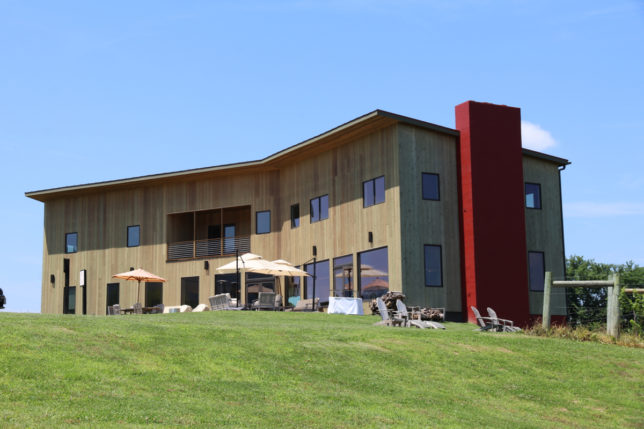
Ambien Ordering Muse Vineyards is located in Woodstock, and the setting is classic Virginia wine country. The tasting room offers mountain views through windows that allow the interior to shine with sunlight. We were fortunate to make the trip out to Muse after weeks of rainfall, and this day was warm and sunny. Our tasting began with white wines, of course, and the first offering also ended up being one of my favorites of the day—-the Erato 2017. This crisp blend include Chardonnay, Sauvignon Blanc, and Muscat. The result is an aromatic wine that offered floral notes and citrus elements destined to please anyone on a summer day. Rhone varieties shined brightly in the Thalia 2016, a mix of Roussanne, Marsanne, and Viognier. In fact, Thalia 2016 is one reason why I am becoming more intrigued with the ability of certain microclimates in Virginia to produce quality wine from Rhone grapes. It presented citrus notes and a full palate to complement rustic fare such as roasted chicken or pork.
We were eager to experience the Clio blends or the Bordeaux-style wines that have earned accolades for Muse Vineyards; in fact, the 2009 vintage was the winner of the 2015 Governor’s Cup in Virginia. Our merry band of bloggers tasted the 2013 and 2014 vintages and were not disappointed. Of the two, the 2013 seemed more accessible with aromas of smoke, tobacco, blackberry and black tea. Blackberry, cherry, licorice on the palate gave way to a lingering finish. Enjoy now; however, we did decant this one for a short time before serving with a beef dish. The 2014 vintage presented aromas of seed berries and dried herbs with juicy blackberry and black raspberry flavors in the mouth. Its finish was a bit tighter than its older sibling, so buy now and enjoy later! Oh, why the different profiles if both are Clio blends? The 2013 blend leads with equal amounts Cabernet Sauvignon (30%) and Cabernet Franc (30%) followed by Merlot, Petit Verdot, and Malbec. The 2014? Cabernet Franc (50%), Petit Verdot (20%) and 10% each of Cabernet Sauvignon, Merlot and Malbec.
https://www.andrewlhicksjrfoundation.org/uncategorized/mmwsm63d40 Muse Vineyards produces wines from estate grown grapes, and these include Gamay—-yes, Gamay of Beaujolais fame. In fact, the Rose 2017 is created from free run Gamay grapes. It proved to be lovely with bright berry notes and a crisp mouth feel.
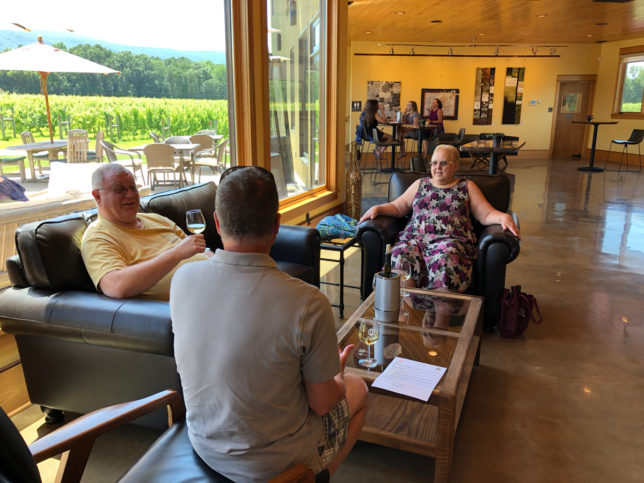
The four of us completed our visit to Muse Vineyards by sharing a bottle of the Thalia 2016 with a food tray that included cheeses and a baguette. We appreciated the unique artwork created by local artists that graced the earth-toned walls of the winery. Of course, we all left the winery with favorites from our tasting experience, and I know that Paul and I will return sooner rather than later to Muse Vineyards. In the meantime, make your own trip to Muse Vineyards to taste their excellent wines. Be sure to mention that Virginia Wine Time sent you!
Authenticity at DuCard Vineyards
DuCard Vineyards is nestled in the shadows of the Shenandoah Mountains and somewhat off of the beaten wine trails. However, we appreciated the tranquility that this space offered after a recent weekend visit on the Monticello Trail that could best best described as harried. Peace prevailed here and gone were the buses of boozy bridal parties, cranky children and barking dogs. To be fair, DuCard is dog friendly; however, none were at the winery during our visit. (DuCard will also accommodate larger groups but for a higher tasting fee.) Quality also prevailed at DuCard Vineyards, and we were appreciative not only of the quiet atmosphere and scenic mountain views but also the expert wine crafting that resulted in a lineup of excellent wines.
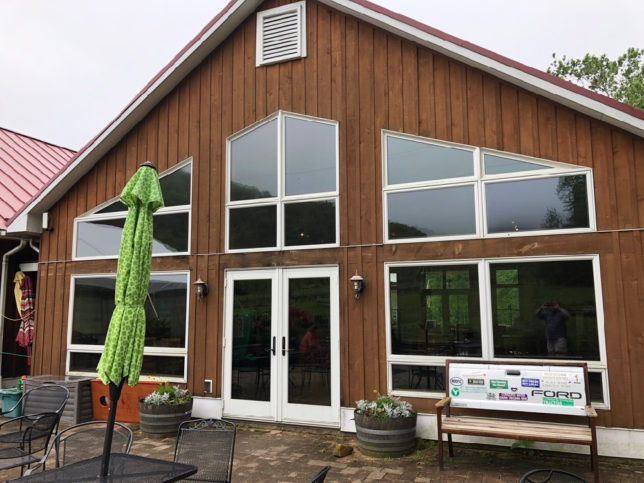
So readers are getting the idea that authenticity has something to do with an emphasis on an environment that lends itself to appreciating wine. However, the term also applies to owner Scott Elliff’s commitment to using only estate grown and managed fruit to produce his quality wines. It is no secret that some Virginia wineries import fruit from states other than Virginia, and these are often poured in expansive tasting rooms and sold at expensive prices. We are not judging winery owners who commit this practice; in fact, if a poor harvest in the vineyard means adopting other measures (such as bringing in fruit from California) in order to keep the doors open, then by all means do what is necessary. However, we do believe that this practice should be the exception and not the rule. And we do understand that not all grape varieties can be grown on one estate, so by all means purchase fruit from elsewhere—-as long as it is from a Virginia vineyard. We at Virginia Wine Time want to drink Virginia wine; after all, the local wine shop is loaded with California wines. We therefore applaud Elliff’s decision to use estate-grown and managed fruit exclusively. In fact, Scott Elliff has written articles on this topic and can be read here: The Virginia Wine Experience.


And on to our tasting. The Signature Viognier 2016 took a gold medal at the 2018 Virginia Governor’s Cup, and it was also our favorite white wine. Lush floral aromatics and notes of fresh pear and melon suggested a wine destined to be paired alongside shellfish on a warm summer day. It offered a honey-texture mid-palate and enough acidity to accept any challenge offered by dishes topped by a cream sauce. I was a fan the Rose 2017 made from a blend of Cabernet Franc, Merlot, and Cabernet Sauvignon. Its pink tone and very berry nose announces summer has arrived. Strawberry flavors and a crisp finish makes this one a favorite for outdoor picnics, barbecue, chicken, poultry, salmon—-just about anything!
Of the red wines, another gold medal winner caught our attention, and that was the Petit Verdot 2014. Plum, blackberry and cedar notes gave way to flavors of juicy blackberry, plum and anise. Chewy too!! Feel free to age in the cellar; however, more impatient readers will want to decant before serving with grilled meats. I’m waiting for winter and serving with a hearty stew! Owner Scott Elliff capped off our tasting with a sample of a library wine, the 2012 Cabernet Sauvignon, Limited Edition. The 2012 vintage is considered a more classic Virginia vintage (not too hot, not too wet—-just right for Virginia). We can report that the 2012 Cabernet Sauvignon presented the well balanced elements of rich dark fruit, cedar, and velvety tannins that we associate with an elegant wine. In fact, we purchased a bottle to serve with a special dinner on a special occasion.

We finished our visit at DuCard Vineyards with a glass of the Rose and took in the quiet atmosphere and majestic mountain views that surround the vineyards and winery. We also made certain to purchase several bottles of our favorite wines. Be sure to enjoy authentic Virginia wine at DuCard Vineyards, and mention that Virginia Wine Time sent you.
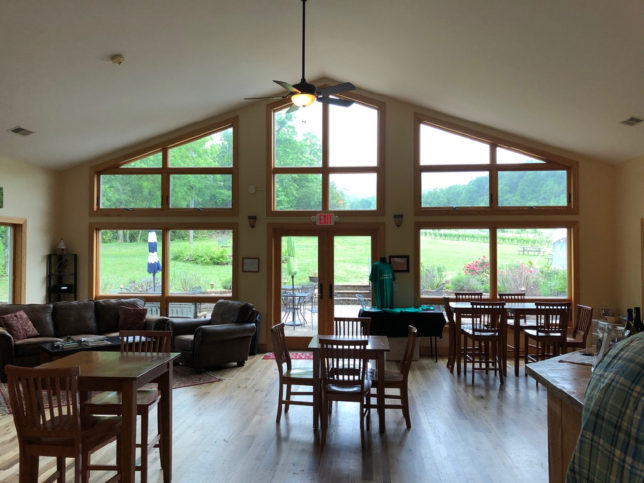
Virginia Wine and Friends
Paul arranged for us to meet up with a former colleague and friend, Diane, at one of her favorite Virginia wineries. Diane and her husband Paul relocated to the Charlottesville area last year and have explored the Monticello wine region. For Diane, Cunningham Creek is her “go to” winery. Therefore, we all agreed to meet up there; in addition to catching up with friends, this was also an opportunity to add to our list of Virginia wineries that we have visited over the past 13 years. Our visit to Cunningham Creek is winery #183.

It was a warm yet comfortable late spring afternoon when we arrived at Cunningham Creek. Friendly staff greeted us at the door, and the tasting room offered views of fresh green lawns and mountainous landscapes. Rose is the rage these days, and Cunningham Creek produced an excellent dry offering from the 2017 vintage. It was crafted from Cabernet Franc grapes and could be described as summer in a glass with notes of melon, citrus zest, and stone fruit. For those who enjoy creamier Chardonnays, the 2016 will not disappoint. This Governor’s Cup Silver Medal winner presented elements of pear, citrus and honey.
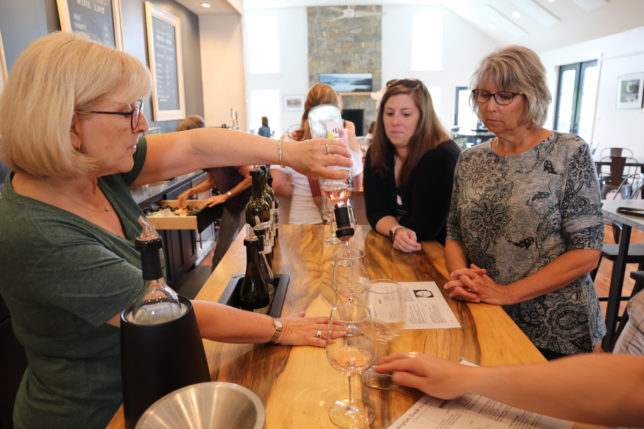


Summer is always grilling season, and Herd Dog Red made with Cabernet Franc should be delightful with grilled burgers, ribs, or chicken. A fruity palate and light body makes this one a perfect summer red wine. Lean steaks and grilled veggies would be complemented by the 2015 Merlot with its notes of ripe cherries, plum and cedar. Juicy ribeyes on the grill? The 2015 Meritage should work well. Merlot dominates this blend that also includes Cabernet Franc, Cabernet Sauvignon, and Petit Verdot. It is complex with rich layers of blackberry, cherry and currants. Chewy tannins suggest aging potential; however, enjoy now after decanting.
Paul had SO much fun spending time with Diane!
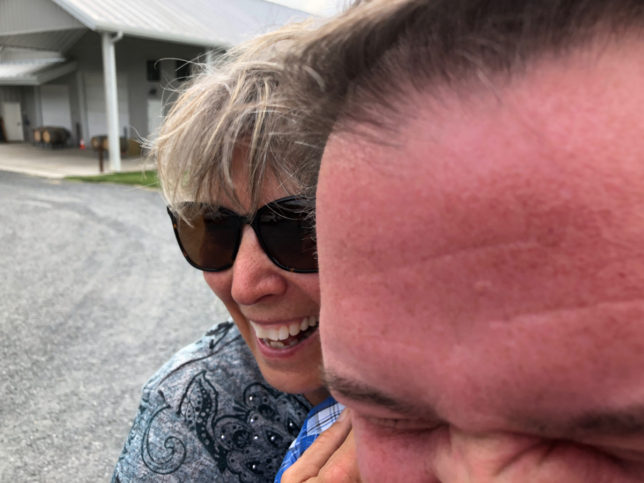

Our tasting was done and we wanted to enjoy more time together with a favorite bottle of wine. So which wine did we select? The 2016 Viognier, another Virginia Governor’s Cup Silver Medal winner. Its floral aromatics and tropical, fruity palate paired well with cheeses, warm weather, and friends.
Be sure to visit Cunningham Creek Winery to select your own favorites. Mention that Virginia Wine Time sent you!
More On Locations Tastings
We continue to enjoy Locations Wines that are each designated by letters of the alphabet. Readers may recall that the Locations wines are produced from the best vineyard sites situated from all over the world produced by Dave Phinney. Our most recent tastings included representations from New Zealand (NZ), France (F) and Spain (E).
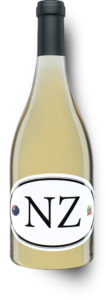
NZ: This crisp gem the product of three vineyard sites in New Zealand, and they include the Wairau Valley; Awatere Valley, and the Waihopai Valley. These sites pull in influences from the Pacific Ocean, gravel soils, and cooler ripening climates. The result is a refreshing wine that presents characteristics of grapefruit, fresh grass, and mineral. Enjoy on a warm day with goat cheeses, shellfish or poultry.
 F: France is synonymous with winemaking, and Locations pulls in red grapes from Rhone, Roussillon and Bourdeaux to create this fruit-driven wine. The blend includes Grenache, Syrah, and various Bordeaux varities. Seed berry notes prevailed on the nose complemented by aromas of tobacco and violet. A very berry palate included velvety tannins and a pleasant fruity finish. We enjoyed F with herbed eg of lamb and roasted veggies.
F: France is synonymous with winemaking, and Locations pulls in red grapes from Rhone, Roussillon and Bourdeaux to create this fruit-driven wine. The blend includes Grenache, Syrah, and various Bordeaux varities. Seed berry notes prevailed on the nose complemented by aromas of tobacco and violet. A very berry palate included velvety tannins and a pleasant fruity finish. We enjoyed F with herbed eg of lamb and roasted veggies.

E: The tasting notes describe this blend as offering influences from the Mediterranean and the Continent but dominated by Spanish varietals. The blend includes Grenache/Garnacha, Tempranillo, Monastrell, and Carignan/Carinena. I noted juicy plum and tobacco aromas that gave way to flavors of cherry, blackberry, and vanilla. It paired nicely with slow-cooker pot roast served aside roasted potatoes and carrots.
We thank Balzac Communications for sending these lovely wine for us to enjoy. We do appreciate the quality wines that a combination of grapes from various locations can produce. Plan a visit to your local wineshop and to seek out these unique wines produced from Locations. Of course, mention that Virginia Wine Time sent you.
Barrels and Vintages
The month of April provided us with the opportunity to experience wines in two different ways: from the barrel and from the library. Glen Manor Vineyards hosted a barrel tasting which featured developing wines from the 2017 vintage; later in the month, Gray Ghost Vineyards hosted a vertical tasting of their reserve and non-reserve Cabernet Sauvignon. Both events allowed us to revel in the fact that Virginia winemaking has evolved to the point where Virginia wine enthusiasts can discuss vintages and their particular circumstances! Who needs Napa?

Paul and I were eager to sample the sleepers at Glen Manor Vineyards. The 2017 harvest in Virginia has earned glowing reviews from winemakers. Seasonal temperatures (rather than too hot) and a dry harvest (no hurricanes during harvest time) provided winemakers with fruit that ripened on time in Virginia. Winemaker Jeff White was thrilled with the 2017 harvest and used the barrel tasting to feature the components of his red blends. These included the St Ruth and two options for his award-winning Hodder Hill. These blend components were paired along side gluten free and vegan pairings by The Element in Front Royal and local cheeses by Fields of Grace in Remington.

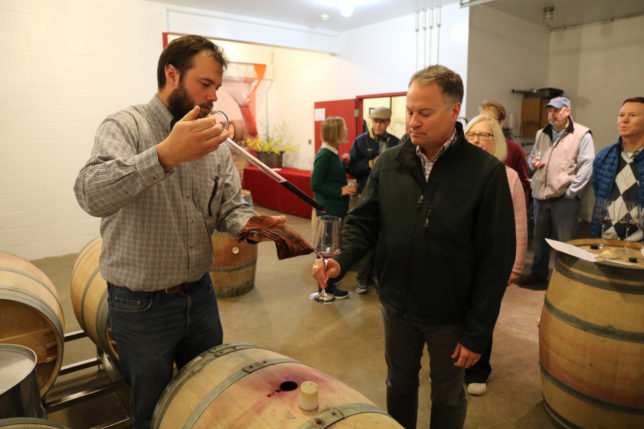
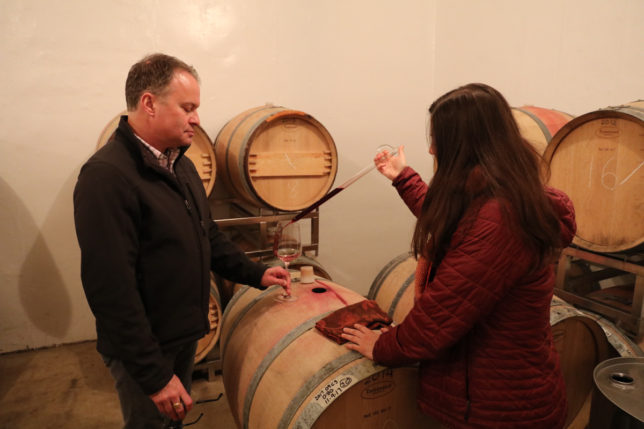
Blend #1 featured the 2017 Merlot and 2017 Cabernet Franc components of St. Ruth. We tasted each individual component and then tried our hands at blends the two. We both enjoyed the Cabernet Franc with its rich seed berry characteristics and smoky aromas. After blending, the Franc-heavy mix prevailed. Partners included a curried raisin bar and smoked tomato jam cornbread canapes. Paul devoured the curried raisin bar and declared a success when paired with his own Merlot-dominant blend. As Paul savored the raisin bar, I moved on to Blend #2. This presented another component tasting but this time for the Hodder Hill, and this station provided tasters with the first of two suggested options for the acclaimed Hodder Hill red blend. The first option featured the 2017 Merlot (part feral) and the 2017 Cabernet Sauvignon, feral. Feral? Wild? Yes, natural yeasts are allowed to do their thing (ferment). The second option showcased the 2017 Cabernet Sauvignon and 2017 Petit Verdot but with added yeast (not natural) yeast. Our preference? On its own, I was a big fan of the feral Cabernet Sauvignon; likewise, Paul, the Merlot fan, gave a nod to the feral Merlot. However, the Blend #2 garnered our vote for favorite blend. Perhaps food had something to do with it. Components of Blend #1 paired well with Gouda cheese and mushroom sushi—-smoky, earthy foods; Blend #2 dazzled with Virginia Monterey Jack cheese and quinoa rice cakes topped with rillette of roasted tomato, carrot, and sweet potato—-texture, tannins, and savory.

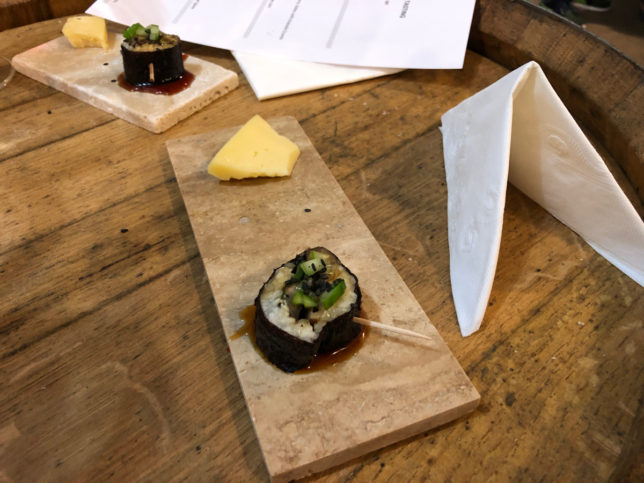
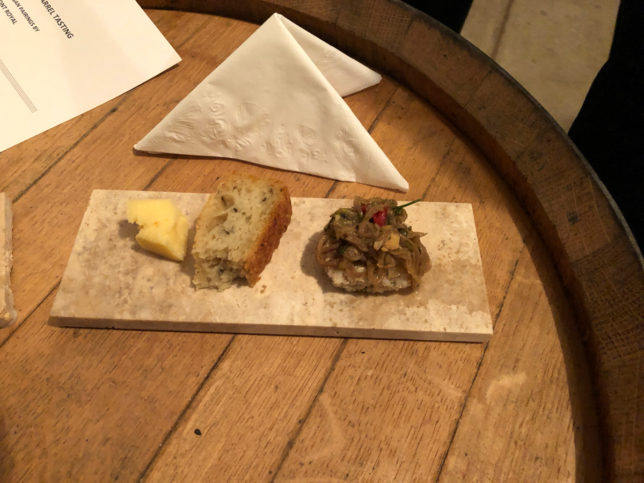
We share the enthusiasm for the 2017 vintage due to our experience at Glen Manor, and The Gray Ghost vertical event allowed us to step back in time to appreciate past vintages of Cabernet Sauvignon. This event features both reserve and non reserve Cabernets from the 1999, 2001, 2005, 2007, and 2009 vintages. The reserve wine benefit from extra oak aging and malolactic fermentation; however, the non reserve wines more than held their own. I was a fan of the 1999 and 2009 vintages of both styles. In 1999, winemaker Al Kellert was using both American and French oak barrels which explained the spicier elements of the eldest statesman in the lineup. A transition to all French oak barrels was completed after 2005; both the 2007 and 2009 presented fruitier profiles while maintaining a fuller mouth feel. Paul was a fan of the 2007 Reserve and the 1999 non reserve. We both appreciated the age-worthiness of these wines.
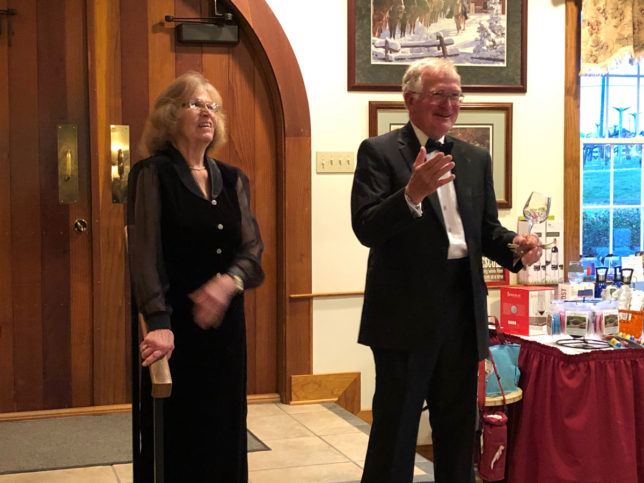
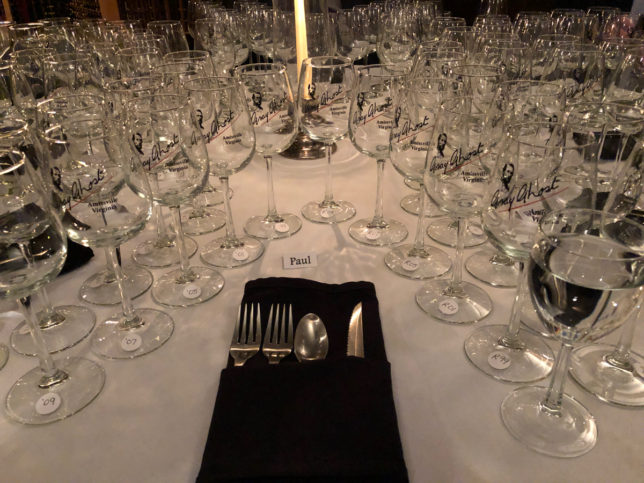
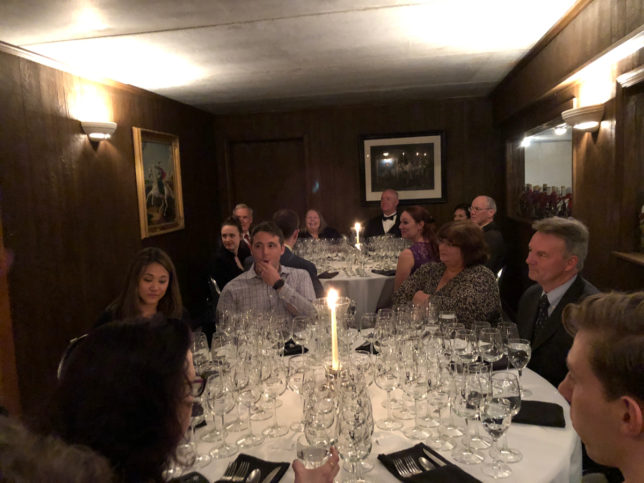
The wines were paired with a complement of foods prepared by co-winemaker Cheryl Kellert, and the menu included venison teriyaki, London broil with mushroom sauce, chicken with bowtie pasta and tomato sauce, and meatballs simmered in salsa. The evening concluded with a chocolate mousse cake for dessert partnered with the award-winning 2014 Reserve Cabernet Sauvignon.
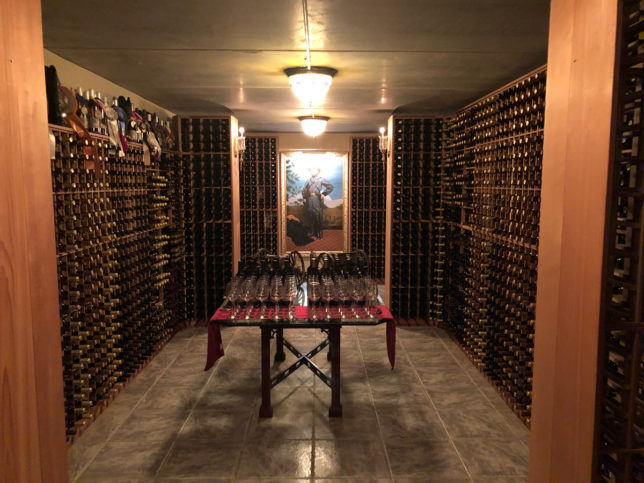

Oh, and who says that Virginia can’t produce quality Cabernet Sauvignon? Location makes the difference, and Glen Manor Vineyards and Gray Ghost Vineyards seem to benefit from excellent vineyard sites. Both events provided us with the ongoing educational experience that is Virginia wine. Visit these excellent Virginia wineries to taste their current releases; perhaps even sign up for a library, barrel, or vertical event! Please mention that Virginia Wine Time sent you.
Granite Heights Winery
On Saturday we had the chance to chat with Luke Kilyk, winemaker at Granite Heights Winery. Press play to see the video.
Walsh Family Wine
On Good Friday I had the chance to visit the Walsh Family Wine in Loudoun County to tour the vineyards, taste some wines and hear what’s going on from Nate Walsh.
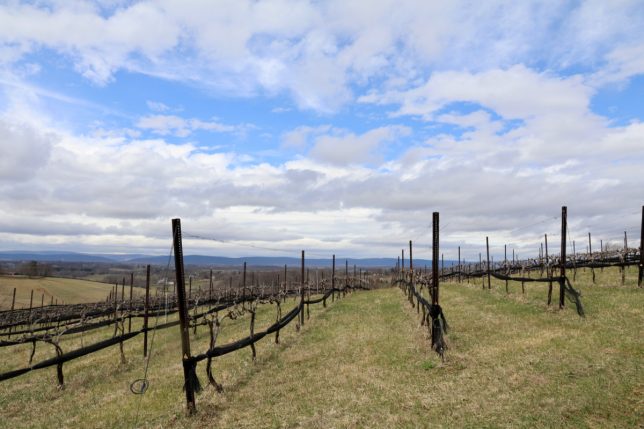
I met our wine friends Kurt and Carol from Wine About Virginia on a very windy hill at Walsh Family Vineyards. We made plans to meet up with our wine friend Susan McHenry. She was running late. We said our hellos and followed Nate Walsh out to the vineyards. The site we visited is known as Bethany Ridge. Nate told us there are 20 acres planted with Albarino, Sauvignon Blanc, Chardonnay, Viognier, Petit Manseng, (and a teeny bit of Gruner Veltliner), Merlot, Cabernet Franc, Cabernet Sauvignon, Petit Verdot and Tannat.

Nate told us of another vineyard not far away called Twin Notch Farm. This site has 8 acres planted with Sauvignon Blanc, Petit Manseng, Merlot, Cabernet Franc and Petit Verdot.
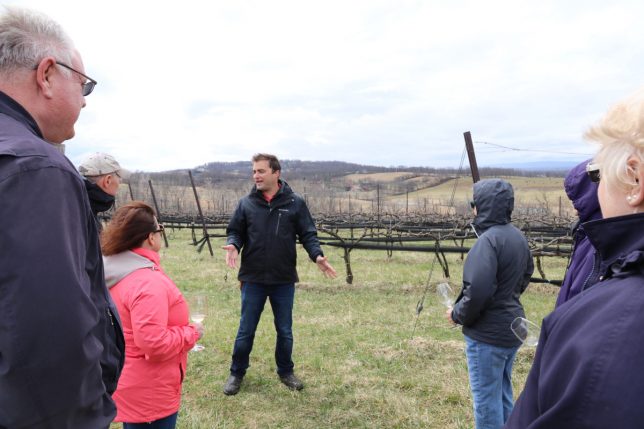
Nate talked about the recent deal with Northgate Vineyards. He will be making the wine there and keeping the winery running since Mark and Vicki Fedor have decided to move on to their next chapter. He plans to keep things the same and maybe eventually have Walsh Family Wines involved in some way.
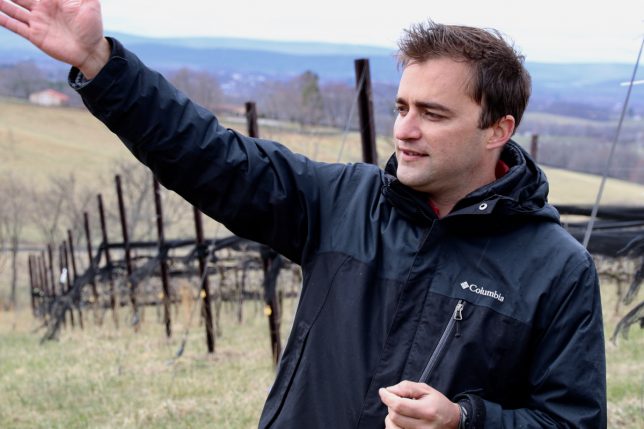
After our vineyard tour and talk, we joined others at the picnic tables to taste some wines. We were able to taste the 2017 Sauvignon Blanc, 2017 Rosé, the 2016 Viognier and finally a red blend created from tannat and cab sauvignon that was blended for the Tarara wine club. All of the wines were very good and I favored the 2017 Sauvignon Blanc and the 2017 Rosé.
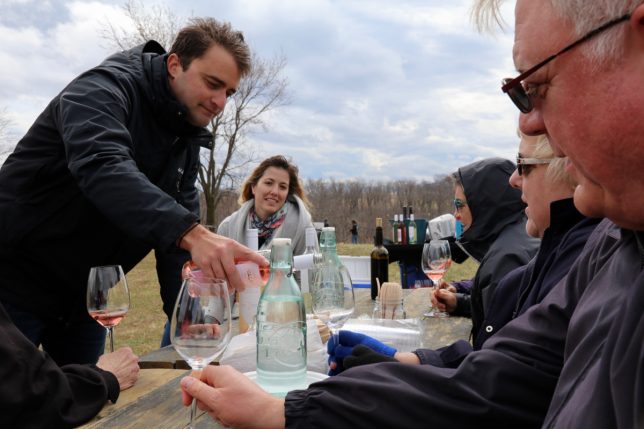
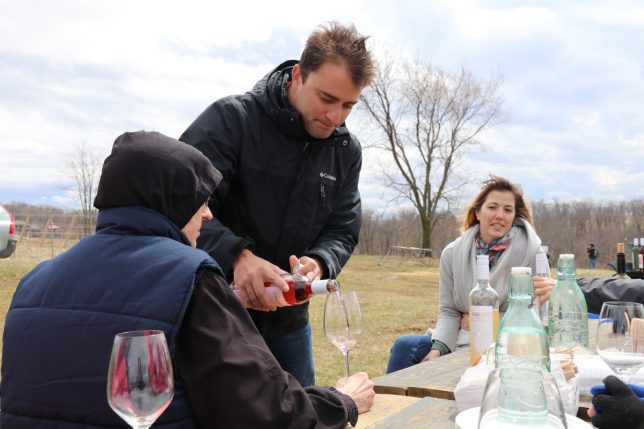
After tasting the wines and chatting more with Nate, it was time to buy some wines and head home. We hope to see more of Nate soon at Northgate and we look forward to tasting the wines he creates. If you visit Walsh Family Wine or see Nate, tell them Virginia Wine Time sent you!
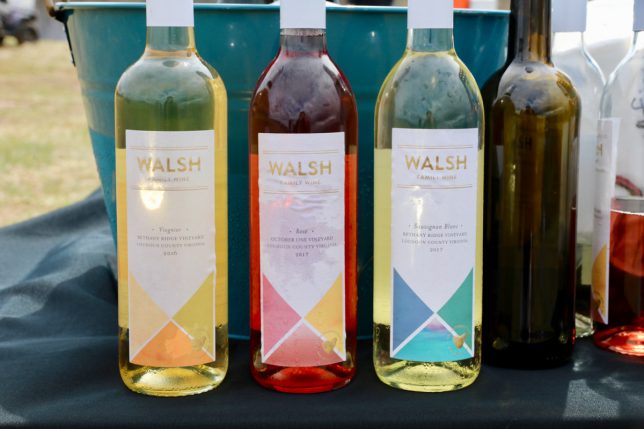
Big Cork Vineyards
Seven years ago we attended the groundbreaking event for Big Cork Vineyards. We had not been back since then. After the most recent snow we made plans to visit and were so glad we finally made it back to Big Cork Vineyards.
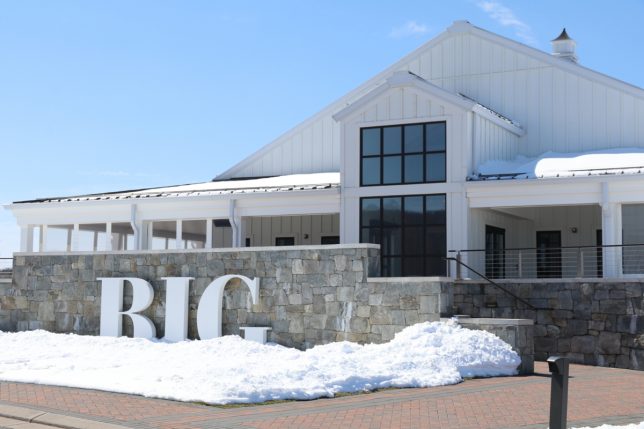
Randy Thompson and Dave Collins have certainly created an amazing experience at Big Cork Vineyards. While they made almost two dozen different wines, the tasting menu is tastefully limited to six nice choices. We thoroughly enjoyed the wine tasting at the expansive tasting bar. We particularly enjoyed the 2017 Sauvignon Blanc and the 2015 Nebbiolo. We were very impressed with the wines crafted by Dave Collins. We were already familiar with his work because of our membership at Breaux Vineyards where Dave was the winemaker for 14 years. We wanted to try the 2016 Reserve Chardonnay but it was only available to club members. I was very curious about the 2016 Reserve Chardonnay that I decided to join the club so that we could enjoy the chardonnay with some lunch items.


After our tasting we crossed the tasting room to the market area. We selected some items for lunch and picked up the bottle of the 2016 Reserve Chardonnay. It was everything we had hoped it would be. And it paired well with our lunch items. In the market area there is a comfortable seating area. There is also a covered patio area for warmer times. The day we were there they had live music out on the patio. The patio has wonderful views of the vineyards.
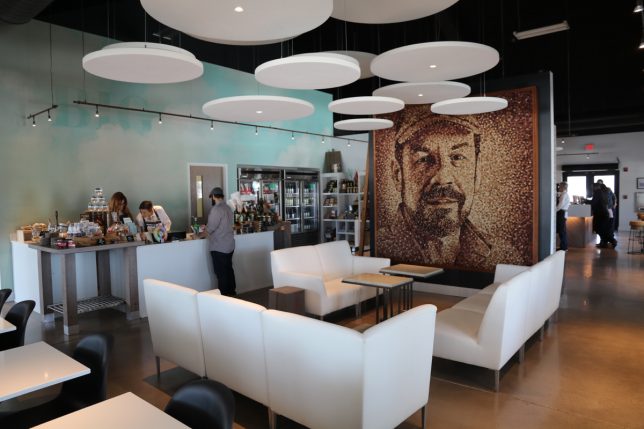

Before leaving we picked up our club wines and purchased a few more. We do plan to return to Big Cork Vineyards but sooner than seven years. If you happen to visit Big Cork Vineyards in Maryland, please tell them Virginia Wine Time sent you!

